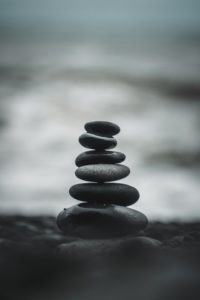“As a solid mass of rock is not stirred by the wind,
So a sage is not moved by praise and blame.
As a deep lake is clear and undisturbed,
So a sage becomes clear upon hearing the Dharma.
Virtuous people always let go. They don’t prattle about pleasures and desires.
Touched by happiness and then by suffering, the sage shows no sign of being elated or depressed.”
-The Buddha (Dhammapada)
What The Buddha says is beautiful. It conjures this image of the unmovable sage, convicted and unworried by the world. But I fear The Buddha is missing something.
That rock may not “stir,” but it does change as the wind and rain wear it down. The deep lake may appear to be clear and undisturbed, but beneath the surface it is teeming with activity and even conflict. And virtuous people may let things go, choosing instead to embrace the calm (which is the essence of equanimity), but their minds will still change and morph over time merely because they are wholly human.
The principle of equanimity is all about finding calm amid the chaos through balance, resilience, and equilibrium. But it doesn’t mean that we must accept a life of passivity, in which we exist without emotion, without vibrancy, and without humanness!
For instance, think about the last time you held a crying baby. Hopefully, you remained calm and composed, choosing to be unmoved by their wailing. But does this mean that you were not taken by some emotion, that you were relegated to checking your humanity and at the door? Of course not.
But why am I bringing up what may seem to be a purely semantic debate?
Well, besides the fact that words are fun, I have seen far too many people react to the tumultuous of this world (which has been even more so in the past year) by seeking refuge in passivity. They may even be doing so under the guise of embracing equanimity, but I fear they’re missing the point.
Seeking Out Quiet
Our lives are rich in beauty, joy, and generosity. But they are also filled with stimulants, poking relatives, burdens, trauma, death, and societal expectations that challenge our ability to find the quiet that allows us to truly and deeply enjoy those riches of life.

This odd mix of chaos and beauty is why I try to challenge myself to reinforce my practice of equanimity as each week, day, or even hour begins, but to do so without resorting to passivity.
Of course, that’s far easier said than done. In fact, I researched and produced an entire section in our program The Focus Factor on the neuroscience behind impulse and equanimity, habituations, and how what we consume can be detrimental to the ability to make those choices.
But what it really comes down to is being gentle with ourselves and cultivating our child-like wonder in everything we do. If we can do that, we can avoid getting caught up in the chaos of all things shiny and, instead, become fully invested in the practice of questioning our relationship with our mind, as we allow ourselves to revel in the true beauty of life.
If any of this hit home for you, you hopefully are beginning to recognize the power and potential equanimity can grant you in your life. To get you started, here are a few excellent ways to begin to cultivate this sense of even-keel-ness.
The 5 Practices to Start Leveraging Equanimity
- Adopt a Mindfulness Practice of Some Sort. It doesn’t need to be legs-crossed-in-padmasana meditation, but cultivating a relationship with your mind and its reactivity and inclination to engage emotionally in real time will help tremendously in this practice. Some of my favorite mindfulness practices include balneotherapy, kinhin, forest bathing, tea meditation, NSDR, or just a run of the mill sit practice!
- Imagine Your Self, But Over There. Remember the scene from The Christmas story where Scrooge got to watch himself from afar? Remember how much he learned as an observer? The practice of looking at your life, your choices, and your relationships as an outsider packs a big punch in the world of gaining perspective.
- Cultivate a Breath Practice. Breath is powerful because it momentarily suspends time (almost anyway!). It allows for our brain to be entirely invested in one thing – the breath, and it’s accompanying sensations — for a few seconds. In moments when we are triggered emotionally, we’re often inclined to engage and react emotionally. Cultivating a breath practice enables us to replace our emotionally-driven decisions with a moment of pause. This allows for more clinical, sensible, and level-headed decisions.
- Be Like Water. Things WILL happen. You WILL be triggered, and occasionally you’ll even react emotionally. Don’t take it personally. Instead, allow those moments to be learning experiences and opportunities to reshape and regroup. Water learns quickly from its environment. It adapts and quickly modifies its shape to accommodate it’s environment. Do the same.
- Be Empathetic. When you are triggered emotionally, or tempted to engage reactively, the moment of pause will also help you listen. Listening means that you are allowing room for empathy – essential for understanding and, therefore, compassion, which is essential in equanimity. Often our inclination is to be offended or take other’s words personally – and this is HARD – but this is an excellent time to try to practice empathy.
With all of today’s tumultuousness causing change within our world, relationships, and even our sense of Self, this practice has never been needed more. No, you don’t need to ship off to a vipassana retreat to start leveraging it. Just start with these 5 simple steps, and give yourself plenty of grace as you explore this practice.
Editor’s note: This article was originally published on December 20, 2020 and was updated to provide additional information.
